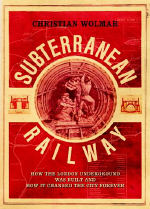Subterranean Railway Review
 MOST people who depend on underground railways try to avoid thinking about them. All being well, the immense difficulty of running closely sequenced trains at depths of as much as 250 feet, along tunnels that may be over a century old, will not make itself apparent during the slog from home to office. When the challenges become evident, misery is the result. So entreaties to pause and consider the engineering marvels running under London and New York may strike the natural audience for these books as perverse.
MOST people who depend on underground railways try to avoid thinking about them. All being well, the immense difficulty of running closely sequenced trains at depths of as much as 250 feet, along tunnels that may be over a century old, will not make itself apparent during the slog from home to office. When the challenges become evident, misery is the result. So entreaties to pause and consider the engineering marvels running under London and New York may strike the natural audience for these books as perverse.
Yet subways have literally shaped both cities. Before they were built, roads were clogged with horses, carriages and pedestrians—one count of London’s commuters in the 1850s found that two-thirds walked. Underground railways meant that the middle classes could combine city jobs and culture with patches of grass. They also enabled the poor to escape overcrowded tenements: the population of New York’s Lower East Side fell by 60% between 1910 and 1940.
London’s was the first underground railway—nearly all of it built in the half-century after 1860—and one of the trickiest. It runs under streets so twisty that they could not simply be dug up in order to lay track—the “cut and cover” method used for much of New York’s system. Another difference is London’s historic lack of civic government, which meant that the money had to be scrounged, mainly from private investors, all of whom had their own ideas on how the system should work.
The lines that now form the backbone of London’s tube system were initially financed and run by a motley crew of domestic and foreign money-men, nearly all of whom ended up poorer as a result. An urban rail system is a natural monopoly, and competition, while it lasted, led to endless disputes. One squabble over a siding in 1884 was resolved by chaining a District line train to the track: three Metropolitan engines tried to pull it loose but failed.
Although, even then, “trains in drains” were a favourite target for grumbling journalists and frazzled commuters, the system that resulted from all this chaos was a marvel. It took 70 minutes to trundle around the Circle Line in the early 1890s—just 12 minutes longer than the fastest journey time today, and that in a train powered by steam. And even the chaos may have been preferable to the indolence and under-funding that prevailed after 1948, when the tube was nationalised.
Christian Wolmar’s book is a better read than Vivian Heller’s, though the latter has splendid photographs of the subway in construction. And perhaps it is a bit unfair of Mr Wolmar to harp on the inability of those who built the tube to appreciate the lasting social benefits of a decent rail system under London, which is to subject them both to hindsight and to an agenda that was not their own. Yet readers of both books may be reassured by tales of past catastrophes that dwarf present annoyances. Open one of them the next time you are stuck in the tunnel outside Edgware Road or Atlantic Avenue, and feel becalmed.
